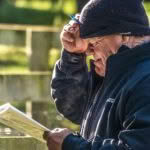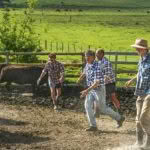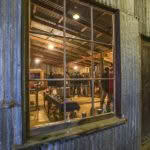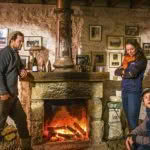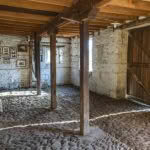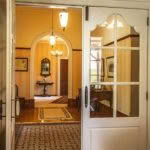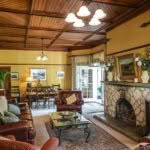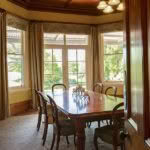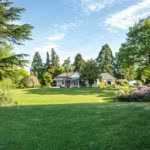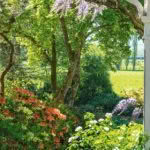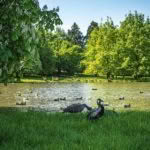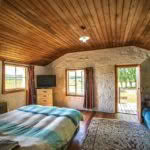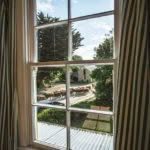Behind the scenes of the annual celebration at Stern Angus Stud’s historic on-farm auction
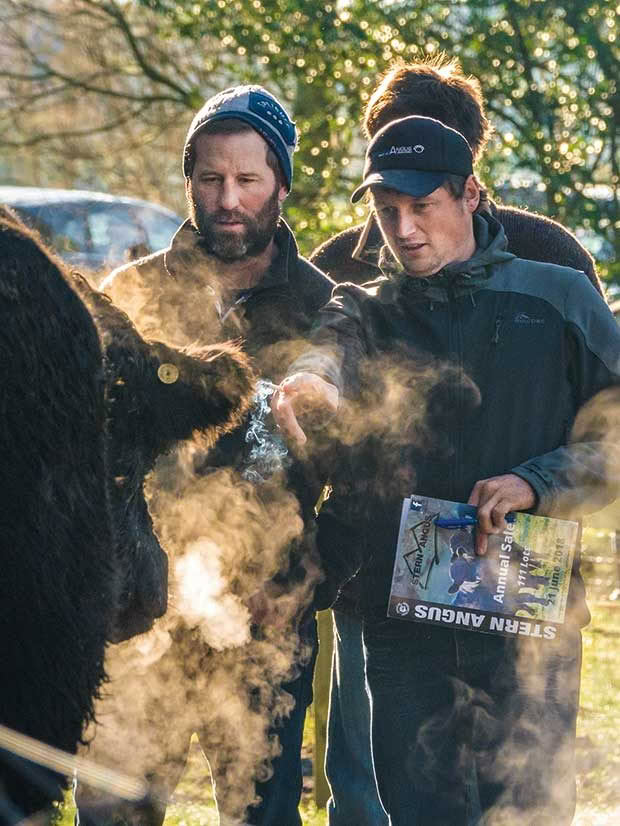
Clients Andrew Law and Chris Pont size options on sale at the Stern Angus Stud.
A historic angus cattle stud takes winter by the horns with a seasonal celebration.
Words: Tanya Moir Photos: Brian High
Every year, on roughly the day of the midwinter solstice, upwards of 250 people from all over New Zealand and beyond descend on a historic stable in a valley northwest of Timaru.
There’s a charge in the chilly south Canterbury air. Behind the limestone walls of Sterndale farm’s stables, 110 rising two-year-old angus bulls are penned. And in just 90 minutes of auction time, the long cycle of work and care that began with the conception of this crop of promising young sires over three years before will at last be complete.
It’s a cause for celebration — and celebration there will be.
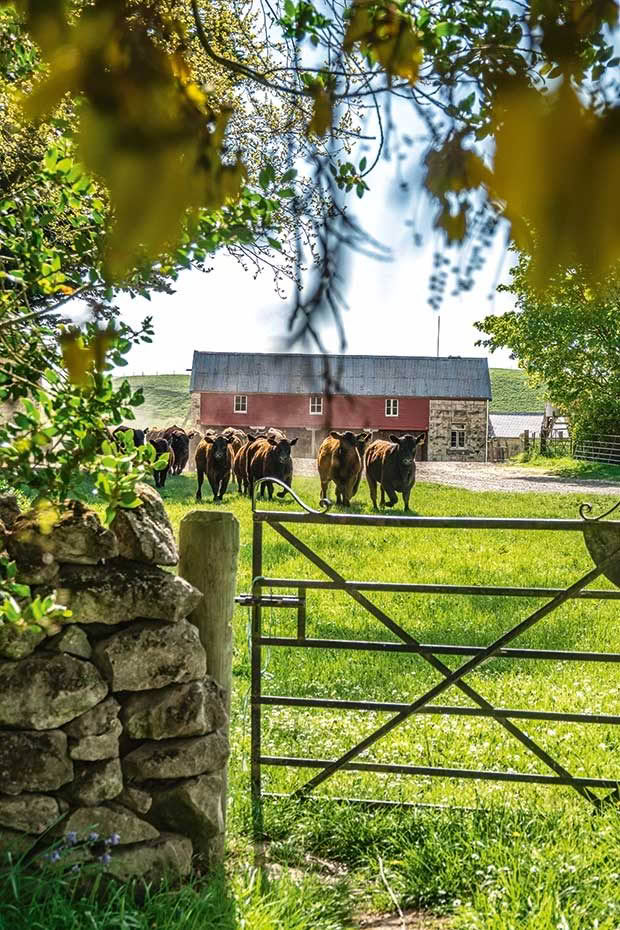
A mob of heifers passes the drystone wall built by James Fraser and his father Robin using stone from neighbouring properties. Iron gates salvaged by Robin from all over the country are a feature on the farm.
In years gone by, the night of the winter sale was often the longest night indeed, and hosts James and Fiona Fraser would still be winkling out revellers and their swags from the haysheds in the bleary dawn of the following morning. In these more temperate times, most guests over-nighting at Sterndale are invited.
This year will mark the 50th anniversary of the Stern Angus Stud’s on-farm auction, an event legendary in the cattle-farming calendar not just for its catalogue but its hospitality.
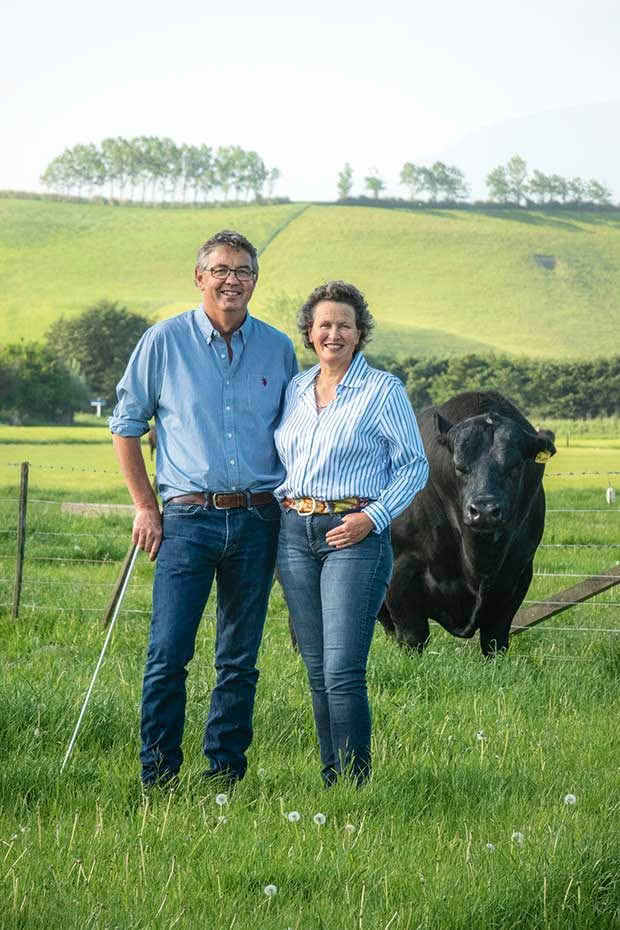
James and Fiona Fraser and the magnificent Mackenzie of Stern.
In the New Zealand Heritage-listed stables, the old fire-places blaze, and throughout the morning clients are met by the Frasers and their team with hot soup, roast beef sandwiches, tea, coffee and baking.
“A lot of them have been up since 5am or 6am,” James explains. “It’s humbling that they’ve gone to such an effort to be with us, and it’s the least we can do to look after them when they get here.”
The event has a powerful sense of family. On one side of the bull ring are clients who have been using Stern Angus lines for 50 years, second- and third-generation buyers.
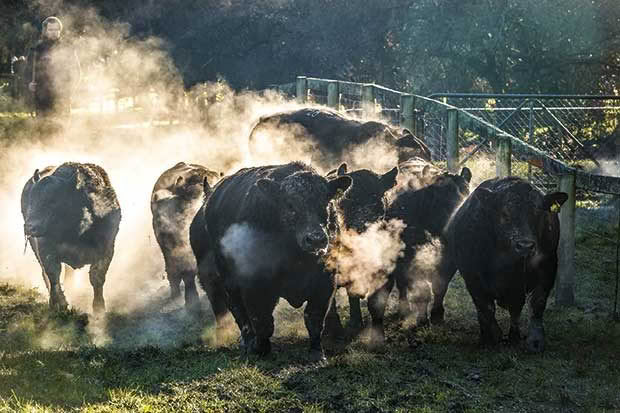
On the other are James and Fiona, Donald Hay, the stud’s stock manager for more than 15 years, and Sterndale’s fourth generation of Frasers: Fiona and James’ youngest son John (23), is employed by the farm full time, while daughter Annabel (28), an architect, and son Rob (26), a rural banking manager, take time out from their careers each year to play their parts in the big day.
There’s atmosphere aplenty, but the sale is also a serious business for all concerned, and the majority of those in attendance aren’t there to prop up the limestone. Future productivity is on the line. A new bull is a weighty investment.
- “If they’ve made the commitment to be here, they’re leaving with a bull,” James says.
- Shepherd Andrew Stonestreet (left) and long-time stock manager Donald Hay (third left) are integral members of the team.
- Behind every sale, there’s a story — the after-sale party begins.
- Friends Reuben Burgess, Annabel Fraser and Katherine Morrow gear up for a long night by the stables fireplace.
- The preservation of Sterndale’s limestone buildings has been a passion for generations of Frasers.
Buyers travel the length of the country through often-appalling winter conditions to be at Stern Angus on auction day. “If they’ve made the commitment to be here, they’re leaving with a bull,” James says. “Or they’re leaving disappointed.”
Winter is the season for bull sales throughout the country, but the timing also has its perils. Bad weather can close roads, leaving clients stranded.
James recalls an eerie silence enveloping the auction ring one year as snow began to muffle the world outside. One by one, he could see his fellow farmers calculating how much a snowfall on Sterndale’s lowland flats meant for the hill-country properties they’d left behind.
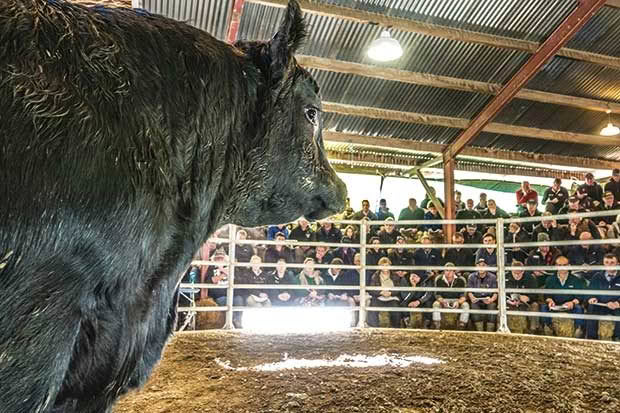
Soon, James and his team were having to scrape snow off the bulls to read the lot numbers on their backs, and every buyer in the room had reached the same conclusion: they needed to buy the next bull that came up and make a run for home to start damage control while they still could.
On another occasion, it was not the buyers who were stranded but the bulls. Rain caused the normally placid Sterndale stream to flood the flats below the sale pens, and the bulls had to be swum back to their paddock.
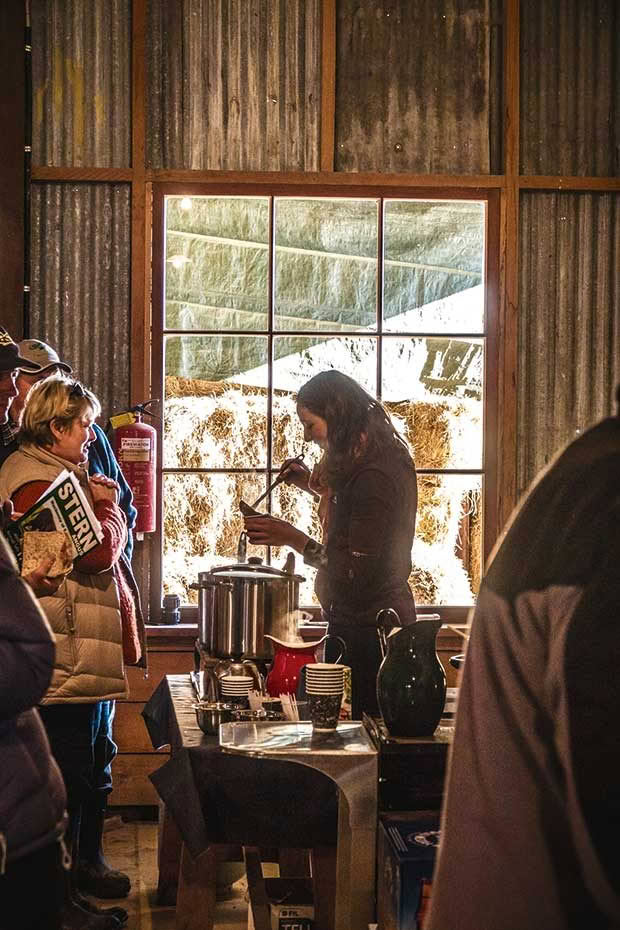
Fiona was alerted to this fact by the arrival of a sodden, scantily clad figure who turned out to be her son Rob, forced to “push” the beasts across the flood by joining them in the water.
Rob was far from being the first of his family to step outside his comfort zone for the sake of a good bull. Back in 1988, arguably some of the darkest economic days for sheep and beef farming in New Zealand, another Robert Fraser (known as Robin), James’ father, paid the record auction price of $41,000 — almost half the cost of the average house at the time — for the bull, Waitapu Governor.
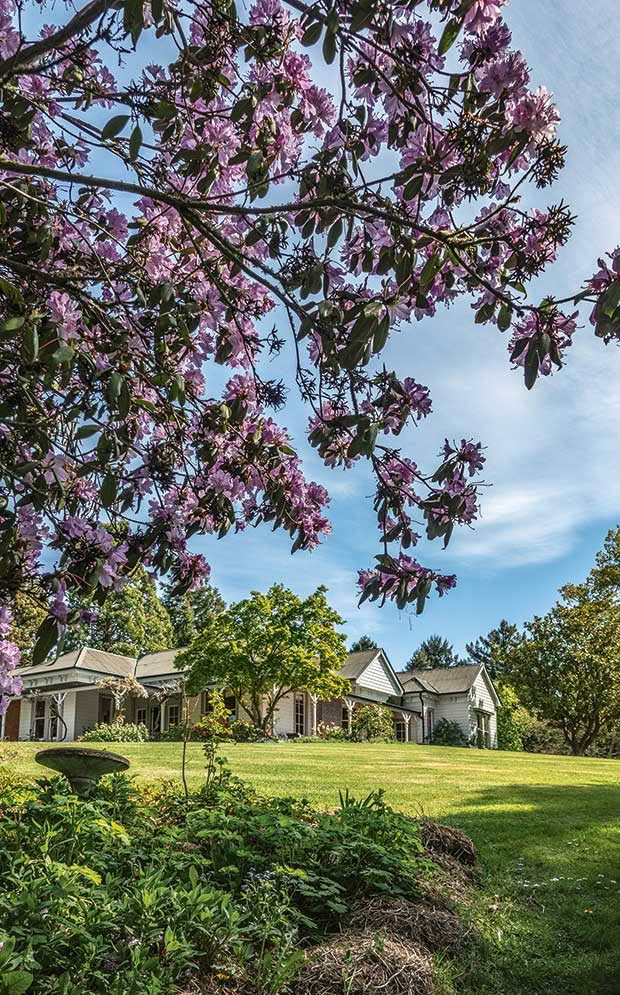
The renovated homestead.
James recalls a reporter asking his father how he could possibly afford such a sum. Robin replied he couldn’t afford to let anybody else have him.
At Stern Angus, cattle are never far from mind. The windows of both homesteads — the first built in the 1870s, the second in 1903 — look over the flats, where the current herd grazes, to the inland ranges where many a Stern bull is busy undergoing what James describes as the ultimate test: to perform against his contemporaries in the tough environment of a client’s hill-country station.
- During their tenure, James’ father Robin and Alison renovated the 1903 homestead.
- They knocked together two rooms to create a large formal living and dining space.
- This necessitated stripping back, matching and replicating original kauri ceilings.
If, however, the windows should fail to provide a glimpse of an angus or two, there are plenty to be had on the current homestead’s walls.
Above the fireplace in the graceful kauri-ceilinged living room hangs an 1884 portrait of Tillyfour Lass, an early progenitor of the Stern Angus line.
“We think she was about cow number five,” Fiona says. “How accurate she is, who would know? But we wouldn’t mind a paddock full of those cows.”
“It’s probably an accurate likeness,” James says. “Not like those.” He gestures towards two elegant prints of improbably straight-backed, dainty-hooved cows on the opposite wall.
In the modern open-plan kitchen/living area at the western end of the homestead, framed photographs of the three Fraser children and James and Fiona’s “alternate family”, three Stern Angus sires — Highlander, Braveheart and Fitzpatrick — face each other across the doorway.
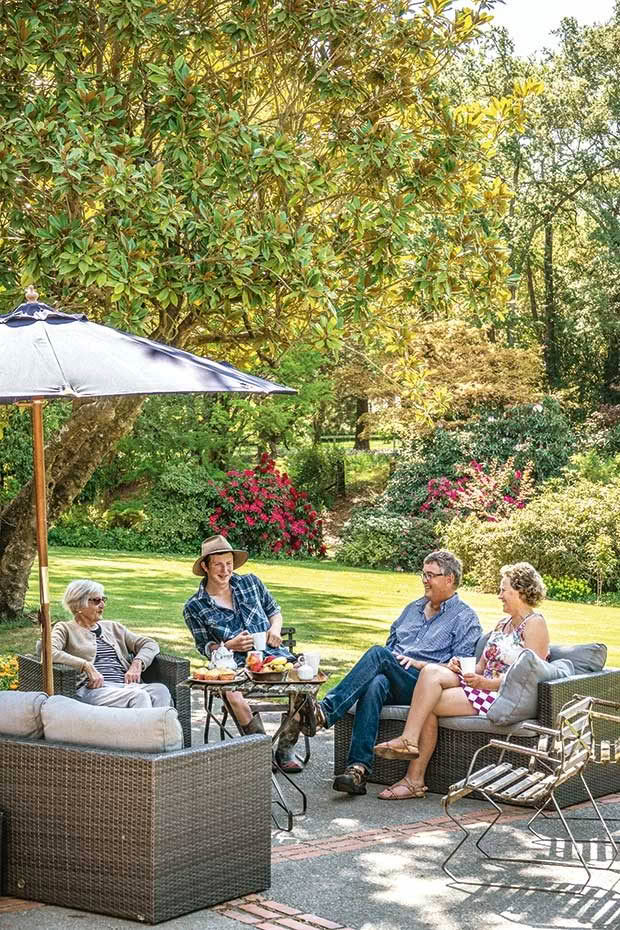
Farming at Sterndale remains a multi-generational affair. Alison Fraser (left) — James’ mother, now living in Christchurch— has a lifetime of cattle breeding experience to share with James and Fiona and their youngest son John (second left).
It was James’ grandfather, Robert “Bob” Fraser, who began the family’s love affair with the breed. Running hereford and angus cattle on his development block in Tokanui in Southland, the returned World War I serviceman found the angus cattle were more suited to the country and “did better”.
It could also be, Fiona suggests with a smile, that Bob Fraser had “just a tiny hint of Scottish blood in his veins”.
The youngest of four children himself, James had no assumptions that he would take over Stern Angus from his parents Robin and Alison. “I enjoyed farming,” he says. “The opportunity was something I always hoped for but didn’t expect.”
- The English trees surrounding the homestead are the legacy of a sustained planting campaign by one generation — Robin and Alison.
- Greenery surrounding the homestead.
- The development of a native wetland among the exotics on the flats below has been a longstanding project for another — James and Fiona.
In fact, James’ early career took a very different turn as a corporate banker in the infamously hedonistic days of another sort of stock market.
“The 1980s were an exciting time, and I wanted to be part of it. “But then,” he adds with deadpan understatement, “it came to a halt.”
In 1989, James and Fiona returned to Sterndale full time, moving into the original 1860s homestead across the rolling woodland garden from his parents’ home, where they raised their own family before taking over the 1903 house, and the reins of Stern Angus, from Robin and Alison in 1997.
The English trees surrounding the homestead are the legacy of a sustained planting campaign by one generation — Robin and Alison; the development of a native wetland among the exotics on the flats below has been a longstanding project for another — James and Fiona.
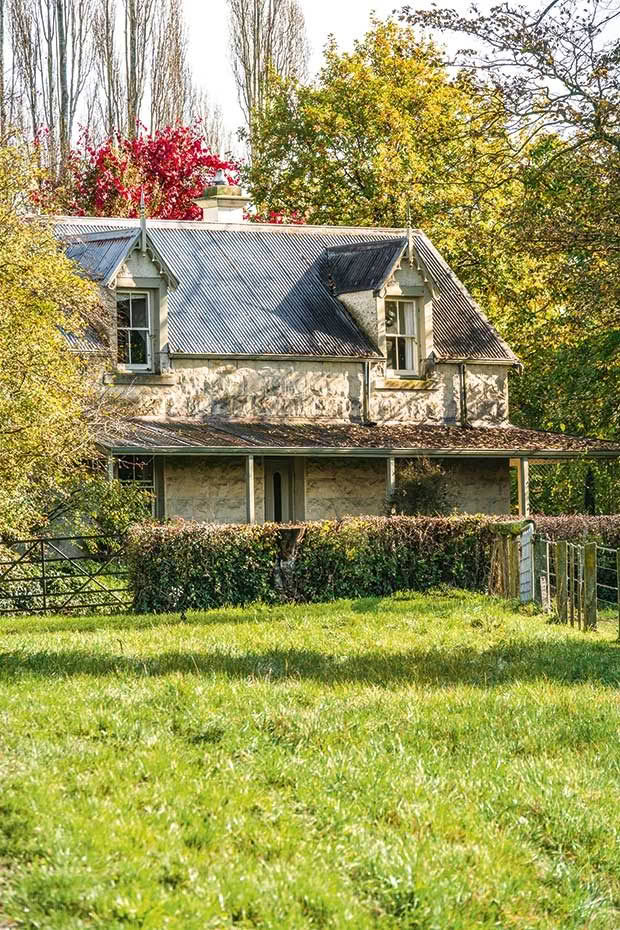
The original three-bedroom homestead was home to Fiona and James and their growing family for eight years.
“It was a 10-year learning process,” James says. At the start, I was very much a farm labourer, but it was always a discussion. My father would always ask us if we could see any other ways of doing things. He was farsighted — he looked to change.
“He was incredibly patient, kind and generous with his time and his thought processes,” Fiona says. “He wanted to understand why we thought what we thought.”
- A painstaking restoration of a section of the old dray shed provides a pied-à-terre for John.
- For more than 150 years, the windows of the old homestead have allowed its occupants to keep an eye on business below.
“He was still making suggestions until the day he died,” James recalls. “He’d see a photograph in a magazine, and ask: ‘Have you seen this animal?’ He loved his cattle.”
TILLYFOUR LASS
In a stroke of serendipity, the original 1884 portrait of Tillyfour Lass found its way to Sterndale’s walls from Fiona’s side of the family rather than James’.
Fiona’s family were shareholders in the New Zealand and Australian Land Company which imported Tillyfour Lass, one of the first six pedigree angus females to arrive in the country. The cow’s portrait hung in the Pattullo family home in Hawke’s Bay until the Napier earthquake of 1913 dislodged it.
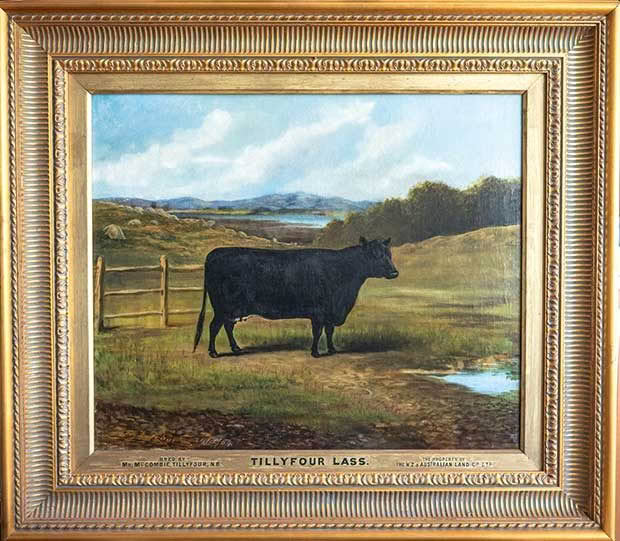
Having suffered a broken frame, Tillyfour Lass was put away and — being among many things needing repair at that time — not rediscovered until the 1960s, when a family member took her to Wellington to hang in his office at Wrightson Stud Stock.
Twenty years later, in Hawke’s Bay, the great-grand-daughter of Tillyfour Lass’s importers met the grandson of a Southland angus breeder with the illustrious cow’s lines in his herd, and the rest is history.
HOW TO LOOK AT A BULL
“He should be masculine. You’re looking for a strong head and jaw. He should be deep-chested and muscular, with good depth of hindquarter.
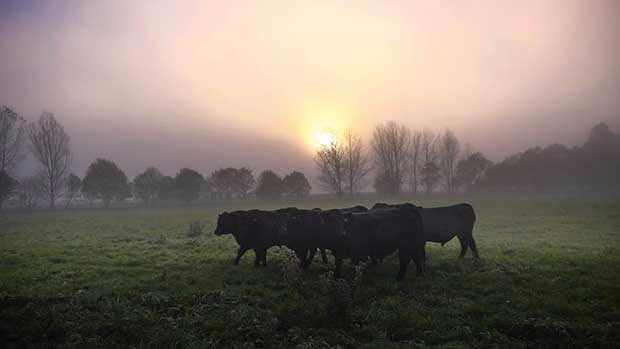
“When you look at an animal, you’re always assessing personality, too. Quietness is important. He also needs top economic performance traits to enter the sale catalogue.” James Fraser.
STERNDALE THROUGHOUT THE YEARS
1867
Sterndale, formerly part of the Levels Run, is freeholded by C.R. Shaw, a local surveyor, who sets about building the original limestone homestead, dray shed and stables.
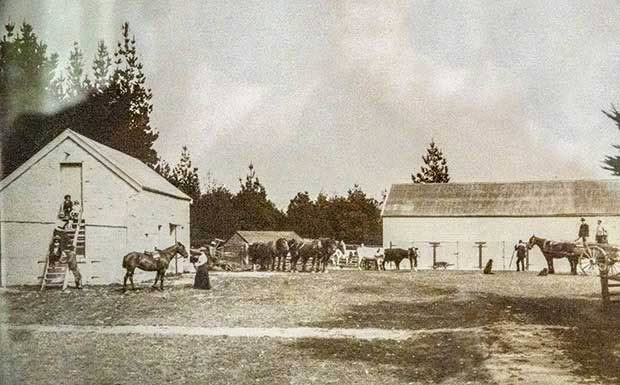
The homestead is future-proofed for extension with a double fireplace on the external south wall, thus placing Shaw a century ahead of the trend for outdoor dining. Together the homestead and outbuildings, now category two listed, form one of the best-preserved collections of early agricultural architecture in New Zealand.
1878
The stables are completed.
1898
Sterndale is sold to Bruce Garrick.
1903
Rather than extend Shaw’s stone house, Garrick builds the current homestead in timber.
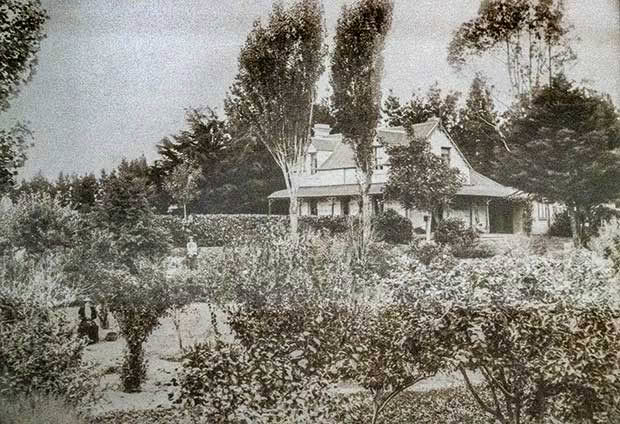
1942
In a depressed land market, Robert “Bob” Fraser, undeterred by rumours of an impending Japanese invasion, scrapes together the cash to purchase most of Sterndale from Garrick’s estate and transfers his Angus stud to the property from Tokanui, Southland.
1954
Robin and Alison Fraser take over Sterndale from Robin’s father, Bob. They begin planting the English trees that now surround both homesteads. Tiring of repeating the stud’s full name on his cattle’s ever-lengthening pedigrees, Robin shortens it to “Stern”.
1969
The stables become the venue for the first Stern Angus on-farm bull sale.
1997
Robin and Alison retire, leaving Sterndale in the hands of James and Fiona.
Love this story? Subscribe now!
 This article first appeared in NZ Life & Leisure Magazine.
This article first appeared in NZ Life & Leisure Magazine.
